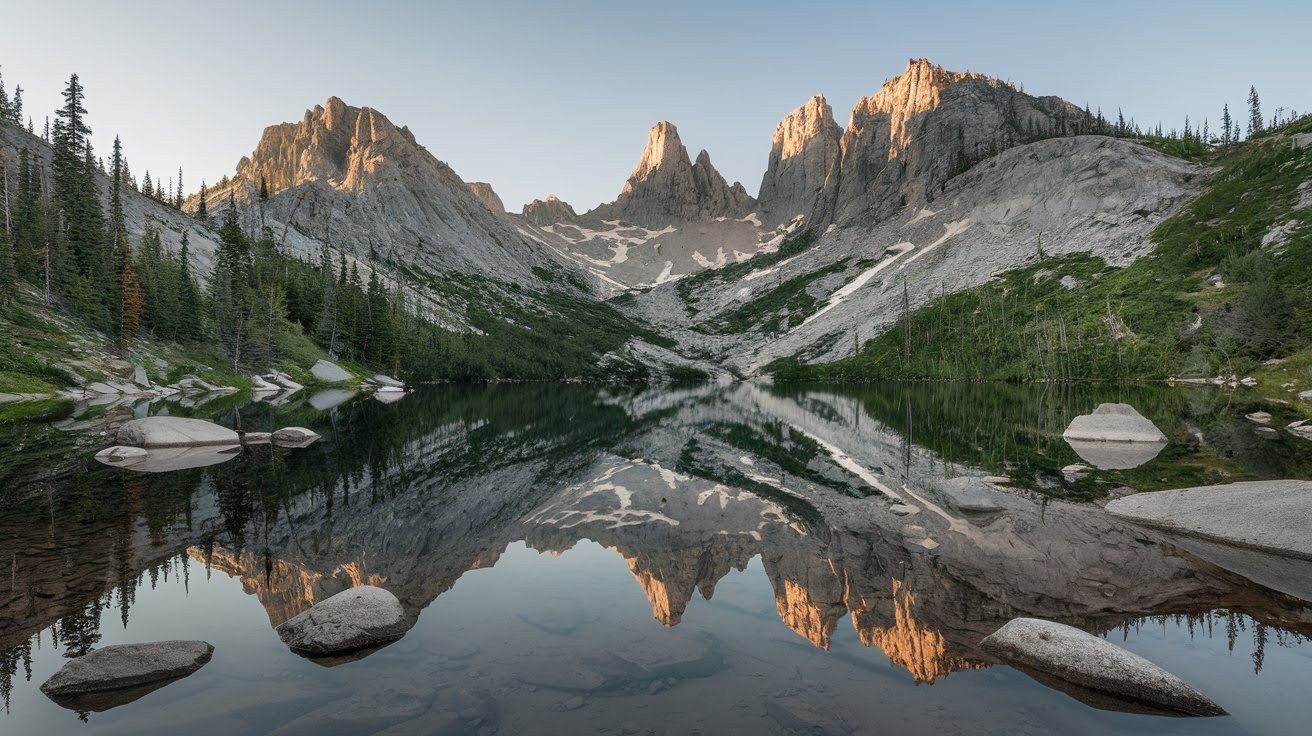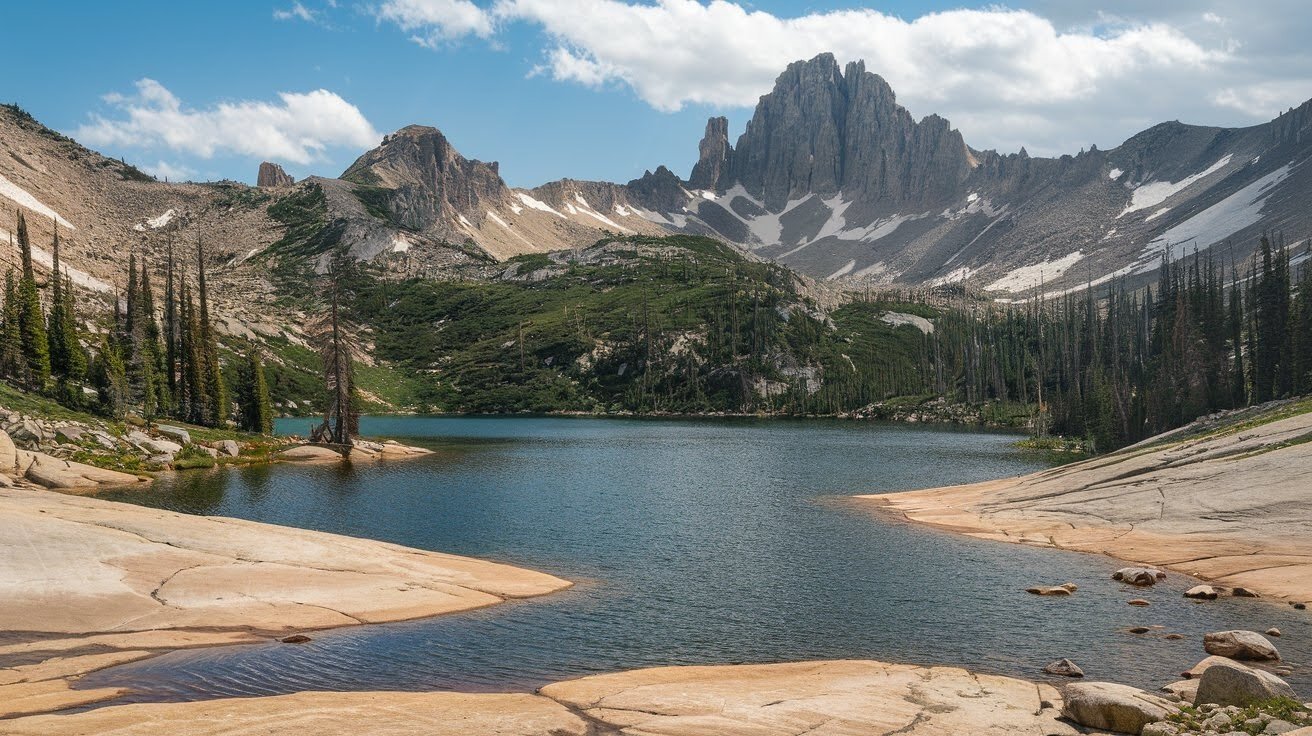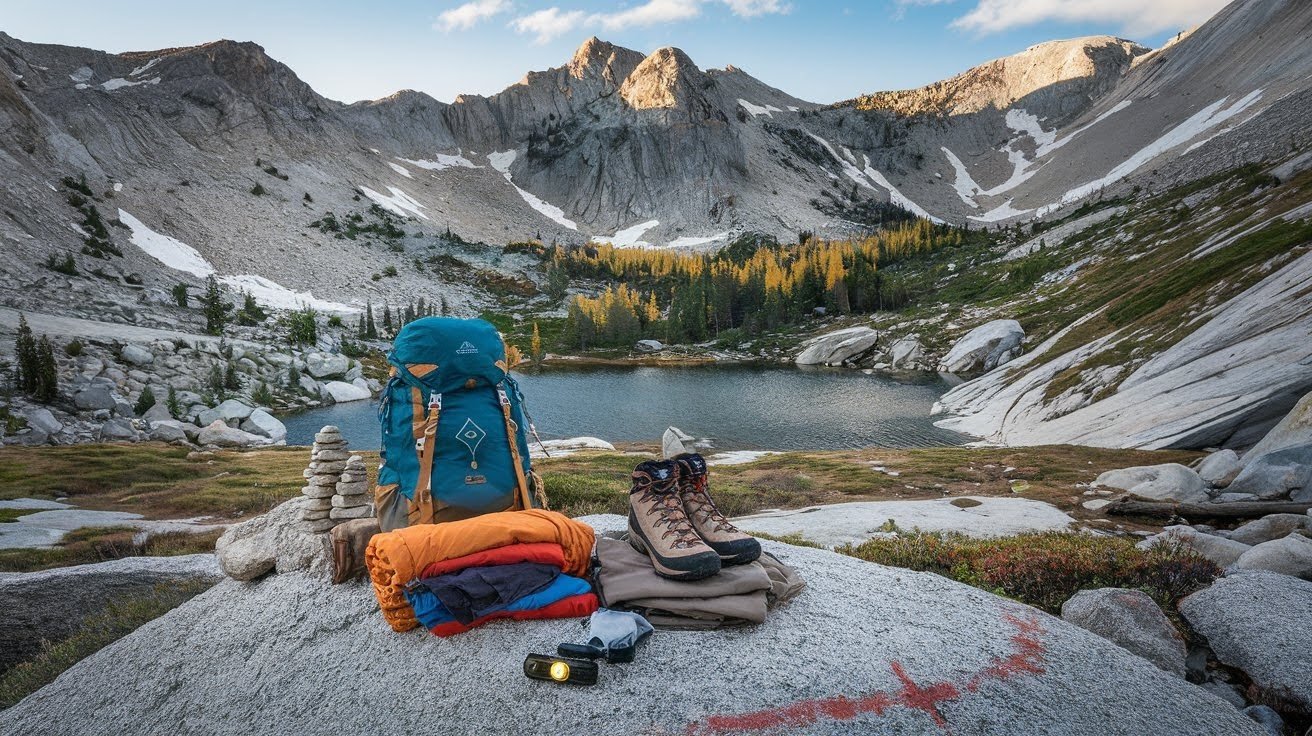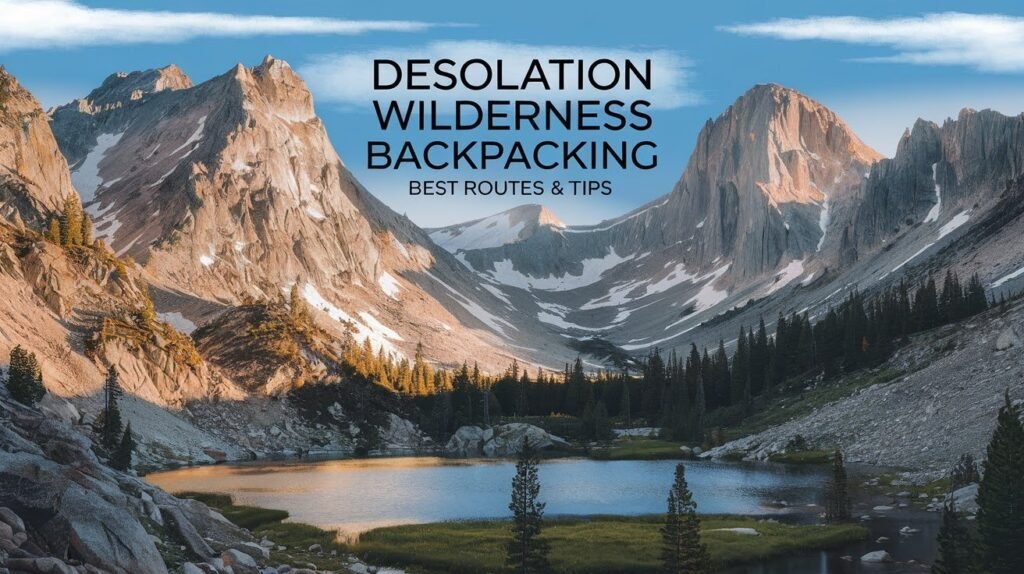What if you could reach pristine alpine lakes and towering granite peaks in just 90 minutes from the Bay Area? Desolation Wilderness makes this dream a reality for thousands of backpackers each year.
With over 130 crystal-clear lakes, dramatic granite formations, and well-maintained trails, desolation wilderness backpacking provides the perfect introduction to Sierra Nevada adventures..
This guide combines firsthand trail experience with current U.S. Forest Service regulations and proven permit strategies that work when reservations open.
You’ll get practical advice based on real camping experiences, common mistakes I’ve seen other backpackers make, and insider tips learned through countless conversations with rangers and fellow hikers.
Every route recommendation comes from personal experience, not just online research.
Planning Your Backpacking Trip In Desolation Wilderness
Success in the Desolation Wilderness starts with proper planning months before your trip. Understanding the permit system, choosing your entry point, and knowing camping rules will make the difference between a smooth outdoor experience and a stressful one.
Permits And Zones
Desolation Wilderness uses a zone-based permit system with 45 different overnight zones. Your permit specifies which zone you must camp in on your first night, though you can move to other zones on subsequent nights. This first-night rule helps spread visitors across the wilderness and reduces crowding at popular lakes.
During peak season from Memorial Day through September 30th, overnight permits are limited by daily quotas for each zone. Popular zones like Lake Aloha and the Velma Lakes fill up quickly, sometimes booking out within hours of becoming available. Outside peak season, permits are still required, but quotas don’t apply, making fall and early spring excellent times for quieter trips.
Permits cost $10 per person for up to 14 days and can be reserved up to 5 months in advance through recreation.gov. If online reservations are full, try calling ranger stations or visiting in person, as they hold back some permits for walk-up availability. Your best chances for popular zones come from booking exactly 5 months ahead when reservations open.
Trailheads And Access
Thirteen different trailheads provide access to Desolation Wilderness, each offering unique advantages depending on your chosen route and camping zone. The trailhead you select will determine your parking situation, hiking distance, and which lakes you can reach most easily.
Four trailheads handle the majority of Desolation Wilderness backpacking trips: Echo Lakes, Eagle Falls, Glen Alpine, and Twin Lakes. Echo Lakes offers the shortest approach to many popular destinations but requires a water taxi ride across the reservoir. Eagle Falls provides direct access to Eagle Lake and the Velma Lakes chain, while Glen Alpine serves as the gateway to Grass Lake and Lake Aloha.
Arrive at popular trailheads by 6 AM during summer weekends to secure parking, as lots fill by mid-morning. Weekday trips offer much better parking availability and fewer crowds on the trails. Consider carpooling or shuttle services during peak times, as overflow parking can add significant walking distance to your trip.
Campsites And Overnight Stays
Most camping in the Desolation Wilderness follows dispersed camping rules, meaning you can set up your tent anywhere that’s at least 100 feet from water sources, trails, and other campers. This system preserves the wilderness feel while protecting fragile lake shores and water quality for wildlife and future visitors.
Four lakes have designated camping areas where the 100-foot rule doesn’t apply: Lake of the Woods, Eagle Lake, Grouse Lake, and Hemlock Lake. These established sites help concentrate impact in areas that can better handle repeated use. Even at designated sites, practice Leave No Trace principles by using existing fire rings and tent sites rather than creating new ones.
Choose durable surfaces like rock, gravel, or established dirt areas for your tent rather than fragile meadow vegetation. Look for natural windbreaks and level ground while staying within wilderness regulations. Good campsite selection makes your night more comfortable while protecting the environment that makes desolation wilderness backpacking so special.
Recommended Backpacking Routes And Itineraries
These proven routes offer the best combination of scenic beauty, manageable distances, and reliable camping options for desolation wilderness backpacking trips. Each route includes specific zone information and difficulty ratings to help you choose the perfect match for your group’s abilities.
1 Night / 2 Day Trips

Grass Lake provides the perfect introduction to overnight wilderness camping with its easy 2.5-mile hike from Glen Alpine Trailhead. The well-marked trail gains just 800 feet in elevation, making it suitable for families and beginning backpackers. The lake sits in a beautiful granite basin with plenty of dispersed camping options and clear water for swimming.
Twin and Island Lakes offer a more challenging option with steady climbing to reach pristine alpine settings beneath Mount Price. The 4-mile approach gains 1,600 feet but rewards hikers with dramatic granite scenery and excellent fishing. Multiple lakes in this area provide backup camping options if your first choice is crowded.
Tamarack Lake sits directly along the famous Pacific Crest Trail, offering crystal-clear waters and easy trail-finding for less experienced backpackers. Lake of the Woods provides the most solitude among overnight options, requiring a longer 5-mile hike but offering designated campsites and fewer crowds. Middle Velma Lake challenges stronger hikers with alpine forest terrain and granite slabs that require basic route-finding skills.
2 Night / 3 Day Trips

Lake Aloha, combined with Tamarack Lake, creates the classic desolation wilderness backpacking experience, showcasing the area’s most iconic granite landscape along the Pacific Crest Trail. This route covers the wilderness’s greatest hits while providing flexibility for side trips to Heather Lake or Gilmore Lake.
The Middle Velma and Dicks Lake Loop forms a perfect lollipop route that includes Eagle Lake, Fontanillis Lake, and the stunning Dicks Lake beneath towering Dicks Peak. This moderate route offers varied scenery from dense forest to open granite bowls while keeping daily hiking distances reasonable.
Grass Lake and Susie Lake provide the most flexible multi-day option, allowing easy access to Lake Aloha, Heather Lake, and several smaller lakes depending on your group’s energy and interests. This route works well for mixed-ability groups since shorter side trips can accommodate different fitness levels.
Wilderness Regulations And Safety
All overnight visitors must carry a signed wilderness permit and present it to rangers upon request. Permits cannot be transferred between people or dates, and violations can result in significant fines that will ruin your wilderness experience.
Campfires are completely prohibited throughout Desolation Wilderness year-round, making lightweight backpacking stoves essential for cooking and hot drinks. Bear canisters are required for all overnight trips regardless of duration, and all scented items, including toiletries, sunscreen, and trash, must be stored inside approved containers.
Human waste must be buried in cat holes 6-8 inches deep and at least 200 feet from water sources and trails, while toilet paper and hygiene products must be packed out completely. Groups are limited to 12 people maximum with stays capped at 14 days, though most permits allow shorter durations to maximize access for other visitors.
Backpacking Tips For Desolation Wilderness

The best weather window for desolation wilderness backpacking runs from July through September, when most snow has melted and temperatures stay comfortable for camping. Early July can still have snow patches at higher elevations, while October brings beautiful fall colors but potential for early winter storms.
Essential gear for Sierra Nevada conditions includes:
- Reliable water filtration system (lakes and streams are abundant)
- Warm sleeping bag rated to at least 30°F for summer nights
- Sturdy hiking boots with good ankle support for granite terrain
- Layered clothing system for rapid temperature changes
- Headlamp with extra batteries for early starts and late arrivals
Most trails are well-marked with signs and cairns, but granite sections can challenge navigation skills when trails cross bare rock. Download offline maps to your phone as backup, and learn to identify trail markers painted on rocks. Dogs are allowed but must be leashed at all times and require the same permit fees and food storage rules as their owners.
Conclusion
Desolation Wilderness offers an unmatched combination of accessibility, natural beauty, and well-maintained infrastructure that makes it perfect for both beginning and experienced backpackers. Its proximity to major population centers doesn’t diminish the authentic wilderness experience waiting among its granite peaks and alpine lakes.
Planning for permits and following Leave No Trace principles ensures this special place remains pristine for future visitors. Start with routes that match your current abilities, and gradually work up to more challenging objectives as your skills and confidence grow.
The memories you create during your desolation wilderness backpacking trips will last a lifetime, from sunrise reflections on still lake surfaces to the satisfaction of reaching a remote campsite under your power.
Frequently Asked Questions
What Is The Best Time Of Year To Visit Desolation Wilderness?
July through September offers the best conditions, with July-August being peak season. September provides fewer crowds and stable weather, while October can be beautiful but risks early snowstorms.
Are Dogs Allowed On Backpacking Trips In Desolation Wilderness?
Yes, dogs are allowed, but must be leashed at all times. They require the same permit fees as humans, and their food must be stored in bear canisters. Owners are responsible for packing out all dog waste.
How Crowded Does Desolation Wilderness Get In Summer?
Popular lakes can be very crowded on summer weekends, especially Saturday nights. Weekday trips offer much more solitude, and choosing less popular zones or trailheads reduces crowds significantly.
Do I Need A Bear Canister For A Short Overnight Trip?
Yes, bear canisters are required for all overnight trips regardless of length. This regulation protects both bears and campers while keeping the wilderness clean and safe.
Are There Any Beginner-Friendly Day Hikes To Try Before Backpacking?
Eagle Falls to Eagle Lake (1 mile each way) and Glen Alpine to Grass Lake (2.5 miles each way) offer excellent introductions to the area’s terrain and trail conditions without overnight commitment.

